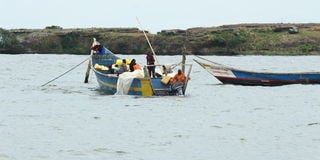EA countries agree on plan to reduce Lake Victoria accidents

An engine boat similar to the ill-fated craft which capsized on Wednesday docks at Lwanabatya Landing Site in Kyamuswa County, Kalangala District in August. PHOTO / Ivan Walunyolo
What you need to know:
The plan includes drawing a fresh navigation map of the lake to replace the existing one, which was done by the British colonialists in 1908
Uganda, Kenya and Tanzania have agreed to implement a joint action plan to improve navigation on Lake Victoria to minimise the rising marine accidents on the water body and improve cross-border trade.
The plan includes drawing a fresh navigation map of the lake to replace the existing one, which was done by the British colonialists in 1908.
The resolution is contained in the recommendations of a meeting by representatives of member countries on the implementation of the Northern Corridor Transit and Transport Agreement (NCTTA) in Kampala yesterday.
The member states stressed the importance of harmonising their water transport policies through conducting joint feasibility studies as well as developing ports on the lake.
“NCTTCA to support member states in funds mobilisation to implement identified gaps in maritime safety, and upgrading and development of regional infrastructure projects,” the report reads in part.
The Executive Secretary of the NCTTA, Mr Omae Nyarandi, said the member states have agreed to fast-track the harmonisation of policies to ensure Lake Victoria becomes safe and productive for the region.
“There are issues of navigation maps, which were developed by the British in 1908 for their interest, we need to see how we can update this so that we look at safety on the lakes,” he said.
The Commissioner for Maritime Administration in Uganda’s Ministry of Works and Transport, Mr Charles Luzigye, who was part of the Ugandan delegation at the meeting, said many activities on the lake are not done in a safe and coordinated manner, leading to many accidents.
“These inland water bodies provide a lot of interconnectivity between nations across borders. But when you assess, you find that 90 percent of the activities that go on in the lake are not transboundary,” he said .
Mr Luzige added: “I think the statistics we received recently were about 5,000 people who perish every year within these inland waterways and, therefore, our plan is to make sure that we provide interventions that provide safety of navigation within the inland waterways.”
A study conducted by Makerere University’s School of Public Health revealed that a total of 3,500 Ugandans across 74 districts drowned between January 1, 2016 and June 30, 2018. The survey further revealed that the number of deaths identified per district ranged from 30 to 287 in lakeside districts and from 47 to 123 in non-lake districts.
The member states, who were represented by Kenya, Uganda, Burundi, DR Congo, Rwanda and South Sudan.
Ms Caroline Adriansen, the head of cooperation at the EU Delegation in Uganda, as well as Mr Ivan Emmanuel Mwondha, the senior transport specialist at World Bank pledged to support the plan’s projects.




